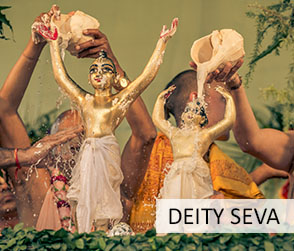h antayam adrir abala hari-dasa-varyo
yad rama-krsna-carana-sparasa-pramodah
manam tanoti saha-go-ganayos tayor yat
paniya-suyavasa-kandara-kanda-mulaih
“Of all the devotees, this Govardhana Hill is the best! O my friends, this hill supplies Krishna and Balarama, along with Their calves, cows and cowherd friends, with all kinds of necessities—water for drinking, very soft grass, caves, fruits, flowers and vegetables. In this way the hill offers respects to the Lord. Being touched by the lotus feet of Krishna and Balarama, Govardhana Hill appears very jubilant.”
– Sri Caitanya-caritamrta, Madhya-lila 18.34, translation
Govardhana Puja is the auspicious festival that was originally performed by Sri Krishna Himself about five-thousand years ago. This festival took place the year following Damodara’s chastisement by His mother, Yasoda Devi, and has been lavishly observed and celebrated worldwide ever since.
As we all know from the pastime, Giriraja honoured a tremendous amount of offerings prepared by the Vrajavasis. This Annakut, or mountain of food, was of gargantuan proportions, but while Giriraja was honouring the offerings, he called out, “Aniyor! Aniyor! Give Me more! Give Me more!” Giriraja consumed more and more offerings, until the Vrajavasis had nothing left in their homes to cook. Sri Balarama, being non-different from the Supreme Personality of Godhead, then understood that there was one thing missing from the offerings – Tulasi leaves. After receiving this final offering of Tulasi leaves, Giriraja was finally satisfied.
Following in the footsteps of the cowherd men of Vraja, the Mayapur devotees prepare a mountain of various delectable dishes to offer to Giriraja. All the major kitchens such as Gada Kitchen, Sulab Kitchen and Gita Kitchen cook massive amounts of bhoga. Many of the community devotees also cook. The brahmanas cook in Radha Madhava’s deity kitchen, and the other community devotees cook in their homes, and bring the bhoga to the temple.
The brahmacaris and the local youth begin building the Annakut hill at around 10am in the morning. Devotees bring more and more bhoga as the day goes on, right up until the massive maha bhoga offering which takes place at midday after the abhisek. The mountain of offerings measures approximately eighteen feet in length, eight feet in width and about three and a half feet in height. Surrounding the mountain, there are hundreds and hundreds of clay pots filled with offerings cooked by the devotees.
Around 11am, Sri Giriraja Maharaja comes down from the altar and a maha abhisek is performed. Unlike the harsh thunderbolts of King Indra, the abhisek offerings gently pour down the transcendental body of Giriraja. He is then finally showered with tumultuous rains of flowers. The Gurukula boys chant mantras in the background to invoke auspiciousness and a thundering kirtan takes place simultaneously. Mixed with the ululating of the assembled women, and the shouting of “Jai!” and “Haribol!”, the temple room somewhat resembles a fraction of what it might have been like five-thousand years ago under the great mountain Giriraja – pure, ecstatic bliss.
Once Giriraja returns to the altar to get dressed in fresh clothes, the devotees assemble in Radha Madhava’s temple hall, waiting for Giriraja to come out again to honour the mountain of offerings. Once the curtains open for maha Arati, after the bhoga has been offered, the devotees participate in yet another ecstatic kirtan, followed by honouring Giriraja’s remnants. All the visiting pilgrims and the assembled devotees, adding up to around four and a half thousand people, are fed sumptuously.
Since Govardhana Puja is the celebration of the King of Mountains, not only is he given a huge mountain of food, he is also given a gigantic cake which measures around twenty-one square feet. This cake is also distributed along with the prasadam. Once everyone has had enough, they retire for the day, and prepare for a shower of bliss in the evening.
To assist everyone’s meditation on Govardhana, a few matajis from the community build a beautiful Govardhana Hill from cow dung and Ganga mud, and decorate it with miniature devotees doing parikrama, cows and animals, temples and kundas.
In the Bhakti-ratnakara, it states how Srila Sanatana Goswami would do Govardhana parikrama daily. As he got older, performing this vow became very difficult, and strenuous on his health; however, that did not stop him, despite the difficulties. Understanding his pain, the Lord came to Him in the form of a small cowherd boy and told Sanatana to give up his vow, as he was too old to continue. Sanatana Goswami didn’t see that as a good enough reason to give up his vow. The gopa boy then produced a Govardhana Sila, or a stone from Govardhana mountain, with the marks of His lotus feet on it and told Sanatana, “If you circumambulate this Govardhana Sila, your vow of walking all the way around Govardhana hill every day will remain intact, for by circumambulating this, you circumambulate Govardhana Hill. You will thereby get the same result, keep your vow intact, and not compromise your religious principles.”
In Mayapur, following the same principle, devotees do parikrama around Giriraja who is present on Sri Sri Radha Madhava’s altar, and most do dandavat parikrama. Some even do dandavat parikrama around each altar – Radha Madhava, Panca-tattva and Lord Nrsimhadeva. Just as Lord Krishna and the Vrajavasis did five-thousand years ago, and Lord Caitanya did with His associates five-hundred years ago, the devotees of the present day do Govardhana parikrama around Giriraja, which is the same as doing Govardhana parikrama in Sri Vrndavan Dham.
While the devotees are engaged in Govardhana parikrama in the evening, an ecstatic kirtan is held in the temple hall to conclude the festival.
vina bhavet kim hari-dasa-varya-
padasrayambhaktir atah srayami
yam eva saprema nijesayoh sri-
govardhano me disatam abhistam
“Without taking shelter of the feet of the hill that is the best of Lord Hari’s servants and full of love for the divine king and queen, how is it possible to attain pure devotional service? May Govardhana Hill fulfill my desire.”
– Govardhanastakam by Srila Visvanatha Cakravarti Thakura
Jai Sri Giriraja Maharaja ki jai!



















Recent Comments